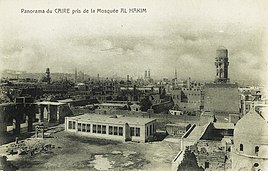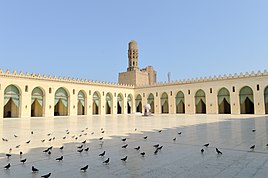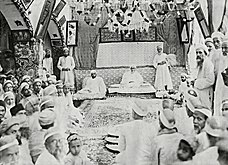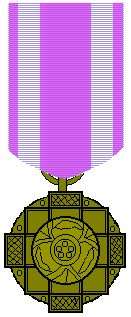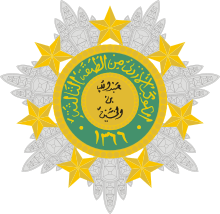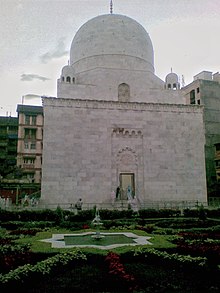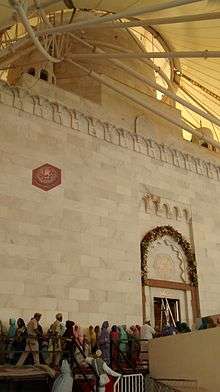Mohammed Burhanuddin
Mohammed Burhanuddin (6 March 1915 – 17 January 2014) was the 52nd Dā'ī al-Mutlaq of Dawoodi Bohras.[3] He led the community for 49 years in a period of social, economic, and educational prosperity.[4][5] He was presented the highest national civic honors of Egypt and Jordan;[3][4] conferred doctorate in Islamic Sciences by Al Azhar University, doctorate in Theology by Aligarh Muslim University, and doctorate in Literature by University of Karachi.[6] He is known in Arab countries as Azamat us-Sultan (lit. 'the Great Sovereign'). He was the first Dā'ī al-Mutlaq to visit Europe, Australia and America.[7] Compared to those of his predecessor, Burhanuddin's policies were aimed at Islamization of his sect.[8]
Syedna Mohammed Burhanuddin 52nd Dā'ī al-Mutlaq of the Dawoodi Bohra | |
|---|---|
مُحـمّـد بـُرهـان الـدِّيـن | |
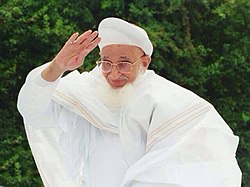 | |
| Da'i al-Mutlaq | |
| In office 1965–2014 | |
| Preceded by | Taher Saifuddin |
| Succeeded by | Mufaddal Saifuddin |
| Title | |
| Other names |
|
| Personal | |
| Born | Mohammed 6 March 1915 |
| Died | 17 January 2014 (aged 98) |
| Resting place | Raudat Tahera, Mumbai |
| Religion | Shi'a Islam |
| Home town | Mumbai, India |
| Spouse | Amatullah Aaisaheba |
| Children | Daughters
Sons
|
| Parents |
|
| Citizenship | Indian |
| Lineage | Alid |
| Sect | Ismailism Dawoodi Bohra |
| Jurisprudence | |
| Other names |
|
| Occupation |
|
| Style | His Holiness |
| Awards | |
| Chancellor, Aligarh Muslim University | |
| In office 3 Oct 1999 – 3 Oct 2002 | |
| Preceded by | Hakim A Hameed |
| Succeeded by | Aziz M Ahmadi |
Early life
Burhanuddin was born to Taher Saifuddin and Husaina Aaisaheba in Surat in the Indian state of Gujarat.[7][9]:16 He was educated by his father, Taher Saifuddin.[10]
At age 12, Burhanuddin survived a car accident in Colombo, Sri Lanka, where his vehicle got hung on one wheel.[7][11] Burhanuddin completed his religious education at the tender age of 13.[6] At 15, he was appointed Amir al-Hajj (Arabic: أمِير الحَجّ, lit. 'chief of hajj pilgrims'), was conferred the title of Shaykh (Arabic: الشيخ, lit. 'leader'), and bestowed the laqab of Burhan al-Din (Arabic: بُرهان الدّيْن, lit. 'proof of faith') by his father, Taher Saifuddin.[11][12]
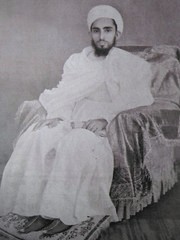
In 1934, Saifuddin designated him as his successor to the office of the Dai al-Mutlaq (Arabic: داعي المطلق, lit. 'absolute missionary'), and subsequently elevated him to the station of Mazoon al-Da'wat (Arabic: مأذون الدعوة, lit. 'authorized missionary'), making him his second-in-command.[11][12] By 1935 Burhanuddin had committed entire Qur'an to memory.[13]
Burhanuddin married Amatullah Aaisaheba in 1937.[11]
Literary works
Rasāʾil Ramaḍāniyya (Epistles)
The following are a list of Rasāʾil Ramaḍāniyya composed by Mohammed Burhanuddin. Each Risalah is given a title according to Abjad numerals equivalent to the Hijri year of its publication:[14][15]
| ID | Title | Title (English) | Hijri | Pub. | Year |
|---|---|---|---|---|---|
| SMB 00 | حكمة الغيبة الحقيقية | Hikmat al-Ghaybah al-Haqiqiyyah | 1385H | ||
| SMB 01 | استفتاح زبد المعارف | Isteftah Zubad al-Ma'arif | 1385H | 1386H | |
| SMB 02 | فيوضات الجنة | Fuyoodhaat al-Jannah | 1386H | ||
| SMB 03 | سلام نضرة النعيم | Salaam Nadrah al-Na'eem | 1387H | ||
| SMB 04 | ذات النور | Zaat al-Noor | 1388H | ||
| SMB 05 | ظهور مجد الفاطميين | Zuhoor Majd al-Fatimiyeen | 1389H | ||
| SMB 06 | بركة صبغة الله | Barakah Sibghah Allah | 1390H | ||
| SMB 07 | نشر الخير [16] | Nashr al-Khayr | 1391H | 1437H | 2017 |
| SMB 08 | ندى الفيوضات [17] | Nadā al-Fūyūdāt | 1392H | 1438H | 2018 |
| SMB 09 | سلسبيل روض القدس [18] | Salsabīl Rawd al-Quds | 1392H | 1439H | 2019 |
Activities
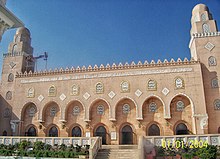
Burhanuddin issued a dress code, calling for male Bohras to grow a beard and wear a white topi and kurta, and for women to wear a colorful two piece abaya, known formally as a Rida. This Islamization countered a trend toward assimilation into the larger culture of their ancestors that was also prevalent under his predecessor, Taher Saifuddin and the previous Du'at before them.[8] The history of this culture can be traced back to the medieval Fatimid dynasty in Egypt.
In 1980 ACE/1401 AH, the Al-Hakim mosque was extensively refurbished in white marble and gold trim by Mohammed Burhanuddin. Remnants of the original decorations, including stucco carvings, timber tie-beams, and Quranic inscriptions were restored as part of the renovations. His intent to restore the ancient Al-Hakim Mosque as a place of worship in contemporary times necessitated a lighting solution that provided this important functionality to the mosque and did so in a manner that paid tribute to the Fatimid tradition of illumination and its aesthetics. The miraculous emergence of the mishkat or small lantern from the niche of the richly decorated façade of Al Jami al Aqmar provided that solution. The niche in which the lantern motif was found has also been compared to the mihrab niche of Al Azhar mosque, the same also now found in Al-Hakim mosque, which has a central motif that resembles a large lamp or lantern.[19]
Educational Contributions
In October 1999, Burhanuddin was elected Chancellor of the Aligarh Muslim University,[20] a position that his father also held. He is credited with expanding the two century old Arabic university Al Jamea tus Saifiyah. In 1983, a new campus of "Al Jamea tus Saifiyah" was built by him in Karachi.[10][21] He built the "Burhaniyah Business Counseling Center" in Mumbai to provide modern business solutions.[10] He also built the Raudat Tahera, a mausoleum of his father Taher Saifuddin in Mumbai, India. It is one of a kind, having the entire Quran inscribed on its inner white walls in letters decorated with of gold leaves and with precious stones.[10][22] It was inaugurated in 1975 by the erstwhile President of India Fakhruddin Ali Ahmed.
In 1976, he established a facility exclusively dedicated to the study of arts and sciences of the Quran.[23]
Community Kitchens
Burhanuddin is credited with the establishment of community kitchens to provide meals everyday to the Dawoodi Bohra families, thus providing free time for women to pursue economic, educational or religious activities.[24] The community kitchens don't discriminate between the privileged and the underprivileged sections, both getting the same "good quality and hygienically-prepared" food,[25] while the community members have the provision of paying for their own family, and for sponsoring those who cannot afford it.[26]
Saifee Hospital
Burhanuddin is also credited with conceptualizing and establishing Saifee Hospital in Mumbai. The hospital is a state-of-the-art, multi-specialty, 250-bed hospital dedicated to providing modern medical care.[27] It was inaugurated in 2005 by Dr. Manmohan Singh, the erstwhile prime minister of India.[28]
Teachings
Ashara Mubaraka
Ashara Mubaraka (Arabic: عشرة مباركه, lit. 'the blessed ten') is an annual mourning of Husayn ibn Ali's martyrdom at Battle of Karbala.[29][30] In the tradition of the Fatimids,[31][32] the Da'i al-Mutlaq delivers ten wa'az (Persian: وعظ, lit. 'sermons') on Islamic philosophy, history, liturgy, expository, horatory over 9 days: One wa'az each day for 8 days starting 2nd Muharram and two on the final day of Ashura (Urdu: عاشوراء), the 10th of Muharram.[29] Every year the Da'i al-Mutlaq selects a city to host the Ashara at[30][33][34] which, at times, attract 100,000 to 200,000 azadar-e Husayn (Urdu: عزادارِ حسين, lit. 'mourners of Husayn').[35][36][37][38][39] The ashara wa'az from the host city is, on occasion, broadcast to various venues around the world.[35][36] Arrangements are made to provide the travelling pilgrims with free accommodation, transportation, and meals.[36][40][41][42] The elaborate Tazyeen (lit. 'decor') of the host venue is undertaken by faculty and members of Funun al-Quran, a department of Aljamea-tus-Saifiyah.[43]
| City | Country | Cont | CE | AH | Start Date | End Date |
|---|---|---|---|---|---|---|
1960s[2]:130 | ||||||
| Mumbai (1) | Asia | 1966 | 1386 | 23 December | 31 December | |
| Mumbai (2) | Asia | 1967 | 1387 | 23 December | 31 December | |
| Mumbai (3) | Asia | 1968 | 1388 | 23 December | 31 December | |
| Mecca (1) | Asia | 1969 | 1389 | 23 December | 31 December | |
1970s[2]:130 | ||||||
| Colombo (1) | Asia | 1970 | 1390 | 23 December | 31 December | |
| Calcutta (1) | Asia | 1971 | 1391 | 23 December | 31 December | |
| Surat (1) | Asia | 1972 | 1392 | 23 December | 31 December | |
| Mumbai (4) | Asia | 1973 | 1393 | 23 December | 31 December | |
| Mumbai (5) | Asia | 1974 | 1394 | 23 December | 31 December | |
| Mumbai (6) | Asia | 1975 | 1395 | 23 December | 31 December | |
| Calcutta (2) | Asia | 1976 | 1396 | 23 December | 31 December | |
| Chennai (1) | Asia | 1976 | 1397 | 23 December | 31 December | |
| Karachi (1) | Asia | 1977 | 1398 | 12 December | 20 December | |
| Jamnagar (1) | Asia | 1978 | 1399 | 5 November | 13 November | |
| Mumbai (7) | Asia | 1979 | 1400 | 5 November | 13 November | |
1980s[2]:130 | ||||||
| Cairo (1) | Africa | 1980 | 1401 | 5 November | 13 November | |
| Cairo (2) | Africa | 1981 | 1402 | 5 November | 13 November | |
| Sidhpur (1) | Asia | 1982 | 1403 | 5 November | 13 November | |
| Karachi (2) | Asia | 1983 | 1404 | 5 November | 13 November | |
| Nairobi (1) | Africa | 1984 | 1405 | 5 November | 13 November | |
| Surat (2) | Asia | 1985 | 1406 | 5 November | 13 November | |
| Indore (1) | Asia | 1986 | 1407 | 5 November | 13 November | |
| Karachi (3) | Asia | 1987 | 1408 | 5 November | 13 November | |
| Mumbai (8) | Asia | 1988 | 1409 | 5 November | 13 November | |
| Surat (3) | Asia | 1989 | 1410 | 5 November | 13 November | |
1990s[2]:130 | ||||||
| Dar es Salaam (1) | Africa | 1990 | 1411 | 5 November | 13 November | |
| Colombo (2) | Asia | 1991 | 1412 | 5 November | 13 November | |
| Pune (1) | Asia | 1992 | 1413 | 5 November | 13 November | |
| Mombasa (1) | Africa | 1993 | 1414 | 5 November | 13 November | |
| Mumbai (9) | Asia | 1994 | 1415 | 5 November | 13 November | |
| Mombasa (2) | Africa | 1995 | 1416 | 5 November | 13 November | |
| Karachi (4) | Asia | 1996 | 1417 | 5 November | 13 November | |
| Surat (4) | Asia | 1997 | 1418 | 5 November | 13 November | |
| Nairobi (2) | Africa | 1998 | 1419 | 5 November | 13 November | |
| Colombo (3) | Asia | 1999 | 1420 | 5 November | 13 November | |
2000s | ||||||
| Surat[2]:130 (5) | Asia | 2000 | 1421 | 5 November | 13 November | |
| Houston[44][45] (1) | North America | 2001 | 1422 | 5 November | 13 November | |
| Indore[30][38] (2) | Asia | 2002 | 1423 | 5 November | 13 November | |
| Mumbai[42] (10) | Asia | 2003 | 1424 | 5 November | 13 November | |
| Dubai[46] (1) | Asia | 2004 | 1425 | 5 November | 13 November | |
| Surat[47] (6) | Asia | 2005 | 1426 | 5 November | 13 November | |
| Mumbai[48] (11) | Asia | 2006 | 1427 | 5 November | 13 November | |
| Colombo[49][50] (4) | Asia | 2007 | 1428 | 5 November | 13 November | |
| Colombo[51][50] (5) | Asia | 2008 | 1429 | 5 November | 13 November | |
| Mombasa[52][53] (3) | Africa | 2008/09 | 1430 | 5 November | 13 November | |
| Marol[35] (1) | Asia | 2009 | 1431 | 18 December | 26 December | |
2010s | ||||||
| Mumbai[54] (12) | Asia | 2010 | 1432 | 8 December | 16 December | |
| Mumbai[lower-alpha 1] (13) | Asia | 2011 | 1433 | 27 November | 5 December | |
| Surat[lower-alpha 2][57] (7) | Asia | 2012 | 1434 | 15 November | 23 November | |
| Mumbai[lower-alpha 3] (14) | Asia | 2013 | 1435 | 5 November | 13 November | |
Awards and honors
- "Order of the Star of Jordan", the highest civic honor of Jordan by the King of Jordan.[58]
- "Order of the Nile", the highest civilian honor of Egypt.[59]
- "Honorary Doctorates", by Al-Azhar University, Egypt, Aligarh Muslim University, India and University of Karachi, Pakistan.[60]
- On 6 March 2011, Burhani Foundation, India made largest distribution of bird feeders (20,631) to celebrate Mohammed Burhanuddin 100th birthday (according to the Islamic calendar). It was recorded in Guinness World Records.[61][62]
- Padma Shri, the fourth highest civilian award of India, in 2015.[63]
- Mohammed Burhanuddin was named one of The 500 Most Influential Muslims in the years 2009, 2010, 2011, 2012 & 2013.[64]
Wafaat/Demise
Burhanuddin died of cardiac attack at his home Saifee Mahal in Mumbai on 17 January 2014.[58] The Bohra community announced a 40-day mourning period in respect of the departed leader.[65] He was buried at Raudat Tahera Mausoleum in Bhendi Bazar, Mumbai beside his father Taher Saifuddin.[60] His second son and his successor, Mufaddal Saifuddin led the Salat al-Janazah (funeral procession) of his father at the Saifee Masjid.[60] Half mast of Flag and state honor was given by Indian Government during his funeral.[66]
The day after his demise, a crowd of supporters peacefully assembled outside his residence to pay their respects; Unfortunately, when the gates were opened to let them in, a human stampede ensued, killing eighteen people.[67] A commemoration service held one year after Burhanuddin's death drew an estimated three hundred thousand bohras to Mumbai; two dedicated townships were built specially to accommodate them.[68]
Succession
Mohammed Burhanuddin, died in January 2014.[69] As per the tenets of the sect[70] each predecessor is required to nominate his successor during his lifetime.[71][72] His death sparked a succession crisis where two rival claimants emerged for the title of 53rd Dā'ī al-Mutlaq:[73] his son, Mufaddal Saifuddin, and his half-brother, Khuzaima Qutbuddin, who was previously Mazoon [74] of the Dawoodi Bohra.[75]
The challenge created a divide in the community with the vast majority aligning with Mufaddal Saifuddin[76][77] whilst a small number aligned with Khuzaima Qutbuddin.[78] Mufaddal Saifuddin assumed control of the Dawoodi Bohra administration and infrastructure. He is largely accepted as the Bohras' leader[79] by governments and other public bodies.[80] The UK Charity Commission[81] has stated in writing, that "our view is that His Holiness Syedna Mufaddal Saifuddin is the current incumbent of the office of Dai al-Mutlaq."[82]
Genealogy
His Holiness Syedna Mohammad Burhanuddin belongs to family of Moulai Fakhruddin and Moulai Hakimuddin.
Trees linking Da'i al-Mutlaq with Muhammad and Maulayi Tarmal[83] | ||||||||||||||||||||||||||||||||||||||||||||||||||||||||||||||||||||||||||||||||||||||||||||||||||||||||||||||||||||||||||||||||||||||||||||||||||||||||||||||||||||||||||||||||||||||||||||||||||||||||||||||||||||||||||||||||||||||||||||||||||||||||||||||||||||||||||||||||||||||||||||||||||||||||||||||||||||||||||||||||||||||||||||||||||||||||||||||||||||||||||||||||||||||||||||||||||||||||||||||||||||||||||||||||||||||||||||||||||||||||||||||||||||||||||||||||||||||||||||||||||||||||||||||||||||||||||||||||||||||||||||||||||||||||||||||||||||||||||||||||||||||||||||||||||||||||||||||||||||||||||||||||||||||||||||||||||||||||||||||||||||||||||||||||||||||||||||||||||||||||||||||||||||||
|---|---|---|---|---|---|---|---|---|---|---|---|---|---|---|---|---|---|---|---|---|---|---|---|---|---|---|---|---|---|---|---|---|---|---|---|---|---|---|---|---|---|---|---|---|---|---|---|---|---|---|---|---|---|---|---|---|---|---|---|---|---|---|---|---|---|---|---|---|---|---|---|---|---|---|---|---|---|---|---|---|---|---|---|---|---|---|---|---|---|---|---|---|---|---|---|---|---|---|---|---|---|---|---|---|---|---|---|---|---|---|---|---|---|---|---|---|---|---|---|---|---|---|---|---|---|---|---|---|---|---|---|---|---|---|---|---|---|---|---|---|---|---|---|---|---|---|---|---|---|---|---|---|---|---|---|---|---|---|---|---|---|---|---|---|---|---|---|---|---|---|---|---|---|---|---|---|---|---|---|---|---|---|---|---|---|---|---|---|---|---|---|---|---|---|---|---|---|---|---|---|---|---|---|---|---|---|---|---|---|---|---|---|---|---|---|---|---|---|---|---|---|---|---|---|---|---|---|---|---|---|---|---|---|---|---|---|---|---|---|---|---|---|---|---|---|---|---|---|---|---|---|---|---|---|---|---|---|---|---|---|---|---|---|---|---|---|---|---|---|---|---|---|---|---|---|---|---|---|---|---|---|---|---|---|---|---|---|---|---|---|---|---|---|---|---|---|---|---|---|---|---|---|---|---|---|---|---|---|---|---|---|---|---|---|---|---|---|---|---|---|---|---|---|---|---|---|---|---|---|---|---|---|---|---|---|---|---|---|---|---|---|---|---|---|---|---|---|---|---|---|---|---|---|---|---|---|---|---|---|---|---|---|---|---|---|---|---|---|---|---|---|---|---|---|---|---|---|---|---|---|---|---|---|---|---|---|---|---|---|---|---|---|---|---|---|---|---|---|---|---|---|---|---|---|---|---|---|---|---|---|---|---|---|---|---|---|---|---|---|---|---|---|---|---|---|---|---|---|---|---|---|---|---|---|---|---|---|---|---|---|---|---|---|---|---|---|---|---|---|---|---|---|---|---|---|---|---|---|---|---|---|---|---|---|---|---|---|---|---|---|---|---|---|---|---|---|---|---|---|---|---|---|---|---|---|---|---|---|---|---|---|---|---|---|---|---|---|---|---|---|---|---|---|---|---|---|---|---|---|---|---|---|---|---|---|---|---|---|---|---|---|---|---|---|---|---|---|---|---|---|---|---|---|---|---|---|---|---|---|---|---|---|---|---|---|---|---|---|---|---|---|---|---|---|---|---|---|---|---|---|---|---|---|---|---|---|---|---|---|---|---|---|---|---|---|---|---|---|---|---|---|---|---|---|---|---|---|---|---|---|---|---|---|---|---|---|---|---|---|---|---|---|---|---|---|---|---|---|---|---|---|---|---|---|---|---|---|---|---|---|---|---|---|---|---|---|---|---|---|---|---|---|---|---|---|---|---|---|---|---|---|---|---|---|---|---|---|---|---|---|---|---|---|---|---|---|---|---|---|---|---|---|---|---|---|---|---|---|---|---|---|---|---|---|---|---|---|---|---|---|---|---|---|---|---|---|---|---|---|---|---|---|---|---|
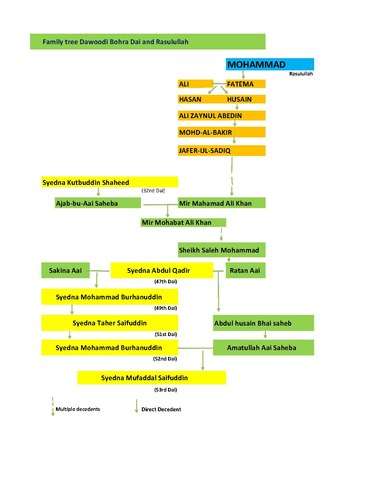
| ||||||||||||||||||||||||||||||||||||||||||||||||||||||||||||||||||||||||||||||||||||||||||||||||||||||||||||||||||||||||||||||||||||||||||||||||||||||||||||||||||||||||||||||||||||||||||||||||||||||||||||||||||||||||||||||||||||||||||||||||||||||||||||||||||||||||||||||||||||||||||||||||||||||||||||||||||||||||||||||||||||||||||||||||||||||||||||||||||||||||||||||||||||||||||||||||||||||||||||||||||||||||||||||||||||||||||||||||||||||||||||||||||||||||||||||||||||||||||||||||||||||||||||||||||||||||||||||||||||||||||||||||||||||||||||||||||||||||||||||||||||||||||||||||||||||||||||||||||||||||||||||||||||||||||||||||||||||||||||||||||||||||||||||||||||||||||||||||||||||||||||||||||||||
Notes
References
- Yumn Mansoor al Yemen – via mahadalquran.com.
- Abdulhussein, Mustafa (1 February 2001). Al-Dai Al-Fatimi Syedna Mohammed Burhanuddin: An Illustrated Biography. Aljamea-tus-Saifiyah Trust. ISBN 978-0953625604 – via books.google.com.
- Wajihuddin, Mohammed (18 January 2014). "Syedna, Dawoodi Bohras' spiritual leader". Mumbai: Times of India. Archived from the original on 3 April 2018.
- "Spiritual Leader Syedna Mohammed Burhanuddin Dead". Newswire. Outlook India. 17 January 2014. Archived from the original on 13 June 2020.
- Raghib, Qureish (15 February 2014). "Syedna Burhanuddin". Milli Gazette. Archived from the original on 19 June 2020. Cite magazine requires
|magazine=(help) - Khan, Akhtar (17 December 2011). "कल गलियाकोट आएंगे डा. सैयदना साहब" [Dr. Syedna Saheb to visit Galiyakot tomorrow]. udaipurpost.com (in Hindi). Archived from the original on 19 June 2020.
- "Know 10 rare facts about Dawoodi Bohra leader Syedna Mohammed Burhanuddin". Archived from the original on 7 January 2018. Retrieved 7 April 2014.
- Blank, Jonah (2001). Mullahs on the Mainframe: Islam and Modernity Among the Daudi Bohras. University of Chicago Press. pp. 184–185. ISBN 0226056775.
- Mohiyuddin, Hozefa (2011). Tasbeeh al Mafakhir [Praiseworthy Feats]. Neelam Publication – via misbah.info.
- "Syedna Mohammed Burhanuddin: A symbol of piety, peace for Dawoodi Bohras". The Hindu. Mumbai. 17 January 2014. Retrieved 7 April 2014.
- Madan, Karuna (17 January 2014). "Syedna Mohammad Burhanuddin in profile". gulfnews.com. New Delhi: Gulf News. OCLC 232115522. Archived from the original on 19 June 2020.
- Bohra, Mansoor Ali (17 January 2014). "Dr. Sayyedna Mohammed Burhanuddin (A.Q.) passes away". udaipurtimes.com. Archived from the original on 19 June 2020.
- "Bohras pray for their leader". mumbaimirror.indiatimes.com. Mumbai Mirror. 26 March 2011. Archived from the original on 21 June 2020.
- ميزة مفتاح خزائن العلوم. Mumbai, India.: Aljamea-tus-Saifiyah, Badri Mahal.
- Traboulsi, Samer (2016). "Transmission of Knowledge and Book Preservation in the Ṭayyibī Ismāʿīlī Tradition". Intellectual History of the Islamicate World – via Brill.
- His Holiness, Syedna Aali Qadr Mufaddal Saifuddin Saheb (1437H). نشر الخير (Nashr al-Khayr) 1391. His Holiness Syedna Aali Qadr Mufaddal Saifuddin Saheb, Badri Mahal, Mumbai, India.
- His Holiness, Syedna Aali Qadr Mufaddal Saifuddin Saheb (1438H). ندى الفيوضات ١٣٩٢. His Holiness Syedna Aali Qadr Mufaddal Saifuddin Saheb, Badri Mahal, Mumbai, India.
- His Holiness, Syedna Aali Qadr Mufaddal Saifuddin Saheb (1439H). سلسبيل روض القدر. Mumbai, India: Badri Mahal.
- El Barbary, Mohamed; Al Tohamy, Aisha; Ali, Ehab (1 February 2017). "Shiite Connotations on Islamic Artifacts from the Fatimid period (358-567 A.H/ 969-1171 A.D) Preserved in the Museum of Islamic Art in Cairo". International Journal of Heritage, Tourism and Hospitality. 11 (3 (Special Issue)): 121–137. doi:10.21608/ijhth.2017.30225. ISSN 2636-414X.
- "Signposts". India Today. 18 October 1999. Retrieved 7 April 2014.
- Khurana, Ashlesha (6 November 2009). "From Gurukul to IBO varsity". The Times of India. Retrieved 7 April 2014.
- "Know 10 rare facts about Dawoodi Bohra leader Syedna Mohammed Burhanuddin". India TV. 12 February 2014. p. 6. Retrieved 7 April 2014.
- A Golden Era. Mumbai, India: Department of Statistics and Information, Dawat-e-Hadiyah. 2016. p. 20.
- Subramanian, Reetika (16 September 2011). "City Bohris start dabba service for community households". Hindustan Times. Mumbai. Retrieved 11 July 2015.
- Ansari, Shabana (9 March 2012). "Bohra women get respite from cooking". DNA. Mumbai. Retrieved 7 July 2015.
- Diggikar, Ranjana (5 July 2015). "Freedom from the kitchen smoke & heat". The Times of India. Aurangabad. Retrieved 7 July 2015.
- "saifee hospital mumbai". Best Hospitals in India Low Cost Treatment | Cost Treatment in India at Best Hospitals.
- "Indian Prime Minister inaugurates Saifee Hospital in Mumbai". wam.
- "Ashara Mubaraka: A Journey Towards Humanity". thedawoodibohras.com. Archived from the original on 1 June 2020. Retrieved 17 June 2020.
- Mahajan, Neeraj (ed.). "Modi & Imam Husain's sacrifice". taazakhabarnews.com. Indore. Archived from the original on 19 June 2020. Retrieved 22 June 2010.
- Sanders, Paula (1994). "Ceremonial as Polemic". Ritual, Politics, and the City in Fatimid Cairo. SUNY. p. 125. ISBN 9780791417812 – via books.google.com.
- Walker, Paul Ernest (2009). الخطب الفاطمية [Sermons of the Fatimids] (in Arabic). I.B Tauris. ISBN 9781845119911 – via books.google.com.
- "In a first, 35,000 Dawoodi Bohras observe Muharram in Chennai". timesofindia.indiatimes.com. Chennai: Times of India. 10 September 2020. Archived from the original on 20 June 2020.
- Muiz, Sarah (10 September 2020). "Ashara mubaraka in all its glory". dailymirror.lk. Colombo: The Daily Mirror Sri Lanka. Wijeya Newspapers. Archived from the original on 22 June 2020.
- "100,000 Dawoodi Bohras in Mumbai for discourses by Syedna". IANS. 22 December 2009. Archived from the original on 17 June 2020 – via twocircles.net.
- "200,000 Dawoodi Bohras attend Mumbai's Moharram discourses". IANS. 13 November 2013. Archived from the original on 17 June 2020 – via The New Indian Express.
Nearly 200,000 Dawoodi Bohras from all over the world attended the 10-day Moharram observance which culminated here Wednesday as Ashura, under the guidance of their 102-year-old spiritual head Syedna Mohammed Burhanuddin...Elaborate arrangements for lodging, boarding, transportation, medical and other requirements of the visitors were made...For the benefit of the global community members, the discourses were relayed live via internet to over 650 community centres.
- Saiyed, Kamal (30 October 2014). "Dawoodi Bohra head praises PM Modi in Muharaam speech". The New Indian Express. Archived from the original on 17 June 2020.
- Shelar, Jyoti (25 August 2018). "Dawoodi Bohras to flock to Indore for Syedna's Muharram sermons". The Hindu. Archived from the original on 17 June 2020.
- Najmi, Quaid (14 December 2010). "Thousands Weep as Bohra Chief, 99, Conducts Moharram Discourse". IANS. Archived from the original on 17 June 2020 – via daijiworld.com.
- De Alwis, Nathasha (6 September 2019). "Annual congregation of Dawoodi Bohra Community in Sri Lanka". newsfirst.lk. Archived from the original on 17 June 2020.
Community members in Colombo have opened their homes to foreign guests, many of whom they’ve never met before. Bus companies have been hired to ferry attendees from different parts of the city. Over the course of the nine days, hundreds of thousands of meals will be served.
- Shelar, Jyoti (6 September 2016). "A journey of faith". India Times. Archived from the original on 17 June 2020.
Syedna holds the waaz at different venues every year with the Bohra jamiats or groups, from across the world, requesting him to select their city as the host. When they send their requests, it means that they are sure that they have the facilities to support the requirements of the gathering. This includes the local travel of visitors between their place of accommodation and the venue, and also their meals
- Farzana Contractor, ed. (25 August 2003). "Syedna At Saifee Masjid". Upper Crust India. Archived from the original on 19 June 2020 – via uppercrustindia.com. Cite magazine requires
|magazine=(help) - "Aljamea-tus-Saifiyah and the Radiant Arts Exhibition in Mumbai". jameasaifiyah.edu. Mumbai. 22 March 2018. Archived from the original on 28 June 2020.
- Hegstrom, Edward (9 March 2001). "Followers pay homage to Muslim leader". chron.com. Houston Chronicle. Hearst Newspapers. ISSN 1074-7109. Archived from the original on 19 June 2020.
- "The Dawoodi Bohra Community of Houston". Archived from the original on 17 June 2020. Retrieved 18 June 2020.
The Dawoodi Bohra community sprouted in the greater Houston area in the 1950s. A few decades later, the community’s growth facilitated the construction of a masjid near the Katy Area, which was inaugurated in 2001 by the late Dr. Syedna Mohammed Burhanuddin (R.A.). The visit occurred during the days of Ashara Mubaraka – held sacred for the memorialization of the martyrdom of Prophet Mohammed’s grandson Imaam Hussain ibn Ali.
- "Syedna in Dubai". Vol. 5 no. 6 (100 ed.). Mumbai: Milli Gazette. 16 March 2004. ISSN 0972-3366. Archived from the original on 19 June 2020. Cite magazine requires
|magazine=(help) - "Community News". Vol. 6 no. 5 (123 ed.). Mumbai: Milli Gazette. 1 March 2005. ISSN 0972-3366. Archived from the original on 19 June 2020.
Bohra spiritual leader Syedna Burhanuddin delivering Muharram sermon at Surat on 17 February 2005
Cite magazine requires|magazine=(help) - Khan, Alifiya; Menon, Vinod Kumar (17 December 2009). "NRIs happily pay Rs 5,000 a day to stay in shanty". midday.com. Mumbai: Mid Day. Archived from the original on 19 June 2020.
2006: The last time the sermon was held in Mumbai.
- Mushtaq, Munza (16 January 2007). "International Bohra leader arrives in Sri Lanka". Colombo: Asian Tribune. Archived from the original on 18 June 2020.
- Yusuf Mamujee (2017). "The Dawoodi Bohras of Sri Lanka". In S. Pathmanathan; B. A. Hussainmiya; Malani Endagama; Vajira Narampanawa; Kalinga Tudor Silva (eds.). People of Sri Lanka (PDF). Ministry of National Coexistence, Dialogue and Official Languages, Government of Sri Lanka. p. 295. ISBN 9789557537030. Archived from the original (PDF) on 18 June 2020 – via reliefweb.int.
- Perer, Quintus (13 January 2008). "Given the present situation, travel industry satisfactory". Colombo: Asian Tribune. Archived from the original on 18 June 2020.
- Mwakio, Philip (5 January 2009). "Community marks festivities in Mombasa". standardmedia.co.ke. Kenya. Archived from the original on 19 June 2020.
- Qureish Raghib (31 December 2008). Kenya President Meets Syedna.
- Wajihuddin, Mohammed (14 December 2010). "Syedna's sermon draws 32,000 at Saifee mosque". Mumbai: Times of India. Archived from the original on 18 June 2020.
- Abbas, Zaheer (6 December 2011). "[Photos] Ashura 2011: Udaipur Bohra commemorate Martyrdom of Imam Hussain". udaipurtimes.com. Udaipur. Archived from the original on 19 June 2020.
- "Dawoodi Bohras pour into Surat for big meet". archive.indianexpress.com. Surat: Indian Express. 13 November 2012. Archived from the original on 18 June 2020.
- "Dawoodi Bohra from world over congregate in Mumbai, observe Ashara Mubaraka in presence of HH Dr. Syedna Mohammed Burhanuddin". Indian Muslim Observer. 15 November 2013. Archived from the original on 18 June 2020.
- "Bohras protest Syedna's half-brother 's claim". The Times Of India. Retrieved 26 March 2014.
- "Leader of Bohra community Dr Syedna Mohammed Burhanuddin dead at 102 - The Express Tribune". The Express Tribune. 17 January 2014.
- "Syedna Mohammed Burhanuddin laid to rest in Mumbai, 70,000+ mourners attend funeral". Retrieved 7 April 2014.
- "Largest distribution of bird feeders". Retrieved 7 April 2014.
- "Mohammed Dilawar's 'save sparrows' campaign enters Guinness record". Retrieved 7 April 2014.
- "Padma Awards 2015". Press Information Bureau. Archived from the original on 26 January 2015. Retrieved 25 January 2015.
- "The Muslim 500".
- "Dawoodi Bohra community spiritual head, Dr Burhanuddin passes away". Retrieved 7 April 2014.
- "Syedna Mohammed Burhanuddin laid to rest in Mumbai, 70,000 mourners attend funeral". Zee News.
- "Funeral stampede kills 18 in Indian city of Mumbai". Bbc.co.uk. 18 January 2014. Retrieved 12 June 2014.
- "Dawoodi Bohras observe late Syedna's death anniversary". DNA India. 5 January 2015.
- "Leader of Bohra community Dr Syedna Mohammed Burhanuddin dead at 102". The Express Tribune.
- Blank, Jonah (2001). Mullahs on the Mainframe : Islam and Modernity Among the Daudi Bohras. University of Chicago Press; 1 edition (15 April 2001). p. 135 & 165. ISBN 978-0-226-05676-0.
- Daftary, Farhad (2007). The Isma'ilis: Their History and Doctrines. Cambridge University Press. p. 275. ISBN 1-139-46578-3.
- Daftary, Farhad (2011). A Modern History of the Ismailis: Continuity and Change in a Muslim Community. I. B. Tauris. p. 333. ISBN 1-84511-717-4.
- Mawani, Rizwan (30 January 2014). "The Intricacies of Succession: Two Claimants Emerge for Dawoodi Bohra Leadership". The Huffington Post. Retrieved 11 February 2014.
- Blank, Jonah (2001). Mullahs on the Mainframe: Islam and Modernity Among the Daudi Bohras. The University of Chicago Press. p. 163. ISBN 0-226-05676-7.
- "Talk of rift among Bohras over Syedna's successor". Hindustan Times. 15 April 2013. Archived from the original on 26 March 2014.
- "Dawoodi Bohras stage a peace march".
- "Bohras make anti-Syedna faction's ex-communication official, stick by Mufaddal Saifuddin".
- ""Over 200 people attended the Mumbai 'misaaq'" - Breakaway Dawoodi Bohra faction alleges harassment".
- Gnostic, Ismaili (5 July 2014). "What is Shia Islam? A Visual Chart of Different Shia Communities". Ismaili Gnosis. Retrieved 15 June 2016.
- "500 muslims" (PDF). Archived from the original (PDF) on 4 April 2016.
- "The Charity Commission - GOV.UK". www.gov.uk. Retrieved 27 August 2016.
- Waring, Kate (15 August 2014). "UK Charity Commission's View regarding The Dawat-e-Hadiyah Trust". Herbert Smith Freehills Solicitors and Nabarro Solicitors (Charity Commission).
- Saifuddin, Aali Qadr Mufaddal (2016). رسالة النعي المسماة - حكمة الغيبة القدسانية الابدية [Hikmah al-Ghaybah al-Qudsāniyyah al-Abadiyyah] (in Arabic).
Further reading
- Abdulhussein, Mustafa (1 February 2001). Al-Dai Al-Fatimi Syedna Mohammed Burhanuddin: An Illustrated Biography. Aljamea-tus-Saifiyah Trust. ISBN 978-0953625604 – via books.google.com.
- Hassanally, Yusuf Mamujee (2017). Gems of History: A Brief History of Doat Mutlaqeen. Colombo: Alvazaratus Saifiyah.
- Najmuddin, Yusuf (1985). Fifty-Second El-Dai el-Fatimi: Seventy-Five Momentous Years in Retrospect. Bombay: Aljamea-tus-Saifiyah – via books.google.com.
- Esposito, John L, ed. (2009). "Muhammad Burhanuddin". Encyclopedia of the Modern Islamic World. Oxford University Press. Archived from the original on 20 January 2015 – via archive.mumineen.org.CS1 maint: unfit url (link)
- Mustafa, Shabbir Hussain (2011). "In Defense of the Community: Syedna Taher Saifuddin and Reassertion of Authority". Between Community and Securalism: The Dawoodi Bohras and Agendas of ‘Reform’ in India, c. 1915-1985 (Thesis). National University of Singapore. Archived from the original on 13 June 2020.
- Electricwala, Mohammed Abbas (2015). Intellectual upliftment through memorization of Quran: A social aspect. inflibnet.ac.in (Thesis). Shri Jagdishparasad Jhabarmal Tibrewala University. Archived from the original on 18 June 2020 – via shodhganga.inflibnet.ac.in.
| Shia Islam titles | ||
|---|---|---|
| Preceded by Taher Saifuddin |
52nd Dā'ī al-Mutlaq 1965-2014 |
Succeeded by Mufaddal Saifuddin |
